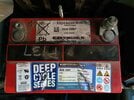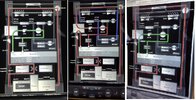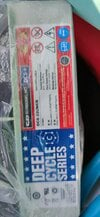Hello everyone
My name is Sean, I come from a M3LR 2020 with huge amount of technical problems, so I have decided to finally get a Model S P85D 2015 (july 15) second hand.
I got the car the 22-Jan-2021. On the 03-feb-2021 I got the warning for warning "12v battery needs to be replaced soon...".
Now, I removed it, reconnected it, the error message disappeared for a couple of hours, then I it appeared again. I called Tesla Roadside Assistance and they told me to schedule a replacement as soon as I was getting back home, there was no rush and the car could be safely driven for a couple of weeks. Fair enough
All considered, in those weeks, I have learnt how to remove and modified my car's front mask, so that I break into my frunk easily in case of lockout and jump start my car. I stored in the frunk also the jump start cables and a spare 12v battery from an ICE car, just to make sure to be self sufficient.
Back home in Finland, it took me a lot, literarily, to get the car serviced due to bureaucracy issues. The battery was finally replaced and the CCS retrofit performed on the 18-03-2021, 6 weeks and 1 days after the first warning.
Now
I have been discussing, on different Tesla Clubs (Finland, Italy and Bulgaria), how long actually the battery can survive, even in the rigid Finnish weather, before dying completely. At the service centre they thought that the usual estimated limit is 4 weeks, but they never actually tested it. I volunteered at that point, and after the CCS retrofit we have put back the old dying 12v battery (DCS-33IT) in place, so that we can actually monitor and see when the 12v will actually end up in a complete drain and get some data on the actually limit time after the warning pops up.
I will keep you up to date on my experiment and let you know when the battery will definitely die.
Yours Sean
My name is Sean, I come from a M3LR 2020 with huge amount of technical problems, so I have decided to finally get a Model S P85D 2015 (july 15) second hand.
I got the car the 22-Jan-2021. On the 03-feb-2021 I got the warning for warning "12v battery needs to be replaced soon...".
Now, I removed it, reconnected it, the error message disappeared for a couple of hours, then I it appeared again. I called Tesla Roadside Assistance and they told me to schedule a replacement as soon as I was getting back home, there was no rush and the car could be safely driven for a couple of weeks. Fair enough
All considered, in those weeks, I have learnt how to remove and modified my car's front mask, so that I break into my frunk easily in case of lockout and jump start my car. I stored in the frunk also the jump start cables and a spare 12v battery from an ICE car, just to make sure to be self sufficient.
Back home in Finland, it took me a lot, literarily, to get the car serviced due to bureaucracy issues. The battery was finally replaced and the CCS retrofit performed on the 18-03-2021, 6 weeks and 1 days after the first warning.
Now
I have been discussing, on different Tesla Clubs (Finland, Italy and Bulgaria), how long actually the battery can survive, even in the rigid Finnish weather, before dying completely. At the service centre they thought that the usual estimated limit is 4 weeks, but they never actually tested it. I volunteered at that point, and after the CCS retrofit we have put back the old dying 12v battery (DCS-33IT) in place, so that we can actually monitor and see when the 12v will actually end up in a complete drain and get some data on the actually limit time after the warning pops up.
I will keep you up to date on my experiment and let you know when the battery will definitely die.
Yours Sean





